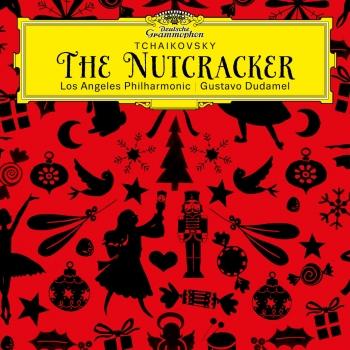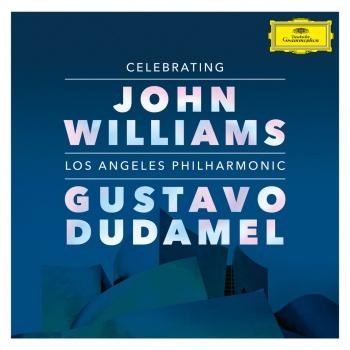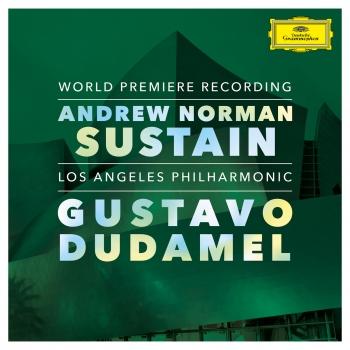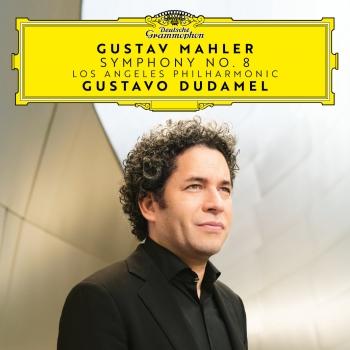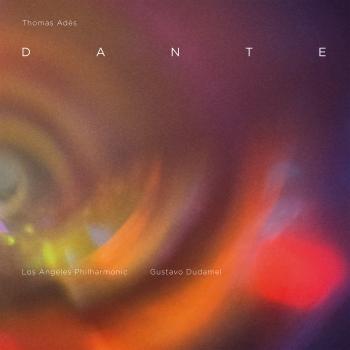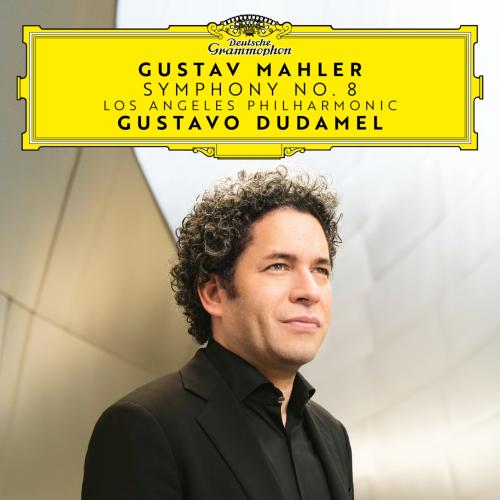
Mahler: Symphony No. 8 in E Flat Major "Symphony of a Thousand" Los Angeles Philharmonic & Gustavo Dudamel
Album info
Album-Release:
2021
HRA-Release:
11.06.2021
Album including Album cover
I`m sorry!
Dear HIGHRESAUDIO Visitor,
due to territorial constraints and also different releases dates in each country you currently can`t purchase this album. We are updating our release dates twice a week. So, please feel free to check from time-to-time, if the album is available for your country.
We suggest, that you bookmark the album and use our Short List function.
Thank you for your understanding and patience.
Yours sincerely, HIGHRESAUDIO
- Gustav Mahler (1860 - 1911): Symphony No. 8 in E Flat Major "Symphony of a Thousand" / Pt. 1:
- 1 Mahler: Symphony No. 8 in E Flat Major "Symphony of a Thousand" / Pt. 1: Veni, creator spiritus 01:21
- 2 Mahler: Symphony No. 8 in E Flat Major "Symphony of a Thousand" / Pt. 1: Imple superna gratia 04:14
- 3 Mahler: Symphony No. 8 in E Flat Major "Symphony of a Thousand" / Pt. 1: Infirma nostri corporis 01:41
- 4 Mahler: Symphony No. 8 in E Flat Major "Symphony of a Thousand" / Pt. 1: Tempo I. Allegro, etwas hastig 01:24
- 5 Mahler: Symphony No. 8 in E Flat Major "Symphony of a Thousand" / Pt. 1: Infirma nostri corporis virtute firmans perpeti 02:29
- 6 Mahler: Symphony No. 8 in E Flat Major "Symphony of a Thousand" / Pt. 1: Accende lumen sensibus 05:18
- 7 Mahler: Symphony No. 8 in E Flat Major "Symphony of a Thousand" / Pt. 1: Qui Paraclitus diceris 04:13
- 8 Mahler: Symphony No. 8 in E Flat Major "Symphony of a Thousand" / Pt. 1: Gloria sit Patri Domino 01:49
- Symphony No. 8 in E Flat Major "Symphony of a Thousand" / Pt. 2:
- 9 Mahler: Symphony No. 8 in E Flat Major "Symphony of a Thousand" / Pt. 2: Poco adagio 05:42
- 10 Mahler: Symphony No. 8 in E Flat Major "Symphony of a Thousand" / Pt. 2: Più mosso. Allegro moderato 03:22
- 11 Mahler: Symphony No. 8 in E Flat Major "Symphony of a Thousand" / Pt. 2: Waldung, sie schwankt heran 04:23
- 12 Mahler: Symphony No. 8 in E Flat Major "Symphony of a Thousand" / Pt. 2: Ewiger Wonnebrand 01:40
- 13 Mahler: Symphony No. 8 in E Flat Major "Symphony of a Thousand" / Pt. 2: Wie Felsenabgrund mir zu Füßen 03:59
- 14 Mahler: Symphony No. 8 in E Flat Major "Symphony of a Thousand" / Pt. 2: Gerettet ist das edle Glied 01:02
- 15 Mahler: Symphony No. 8 in E Flat Major "Symphony of a Thousand" / Pt. 2: Jene Rosen, aus den Händen 02:02
- 16 Mahler: Symphony No. 8 in E Flat Major "Symphony of a Thousand" / Pt. 2: Uns bleibt ein Erdenrest 01:41
- 17 Mahler: Symphony No. 8 in E Flat Major "Symphony of a Thousand" / Pt. 2: Ich spür' soeben 00:33
- 18 Mahler: Symphony No. 8 in E Flat Major "Symphony of a Thousand" / Pt. 2: Hier ist die Aussicht frei - Freudig empfangen wir 00:37
- 19 Mahler: Symphony No. 8 in E Flat Major "Symphony of a Thousand" / Pt. 2: Höchste Herrscherin der Welt 02:15
- 20 Mahler: Symphony No. 8 in E Flat Major "Symphony of a Thousand" / Pt. 2: Jungfrau, rein im schönsten Sinne 01:29
- 21 Mahler: Symphony No. 8 in E Flat Major "Symphony of a Thousand" / Pt. 2: Äußerst langsam. Adagissimo 01:32
- 22 Mahler: Symphony No. 8 in E Flat Major "Symphony of a Thousand" / Pt. 2: Dir, der Unberührbaren - Du schwebst zu Höhen 02:03
- 23 Mahler: Symphony No. 8 in E Flat Major "Symphony of a Thousand" / Pt. 2: Bei der Liebe, die den Füßen 00:56
- 24 Mahler: Symphony No. 8 in E Flat Major "Symphony of a Thousand" / Pt. 2: Bei dem Bronn, zu dem schon weiland 01:24
- 25 Mahler: Symphony No. 8 in E Flat Major "Symphony of a Thousand" / Pt. 2: Bei dem hochgeweihten Orte 01:02
- 26 Mahler: Symphony No. 8 in E Flat Major "Symphony of a Thousand" / Pt. 2: Die du großen Sünderinnen 01:37
- 27 Mahler: Symphony No. 8 in E Flat Major "Symphony of a Thousand" / Pt. 2: Neige, neige, du Ohnegleiche 00:40
- 28 Mahler: Symphony No. 8 in E Flat Major "Symphony of a Thousand" / Pt. 2: Er überwächst uns schon 01:15
- 29 Mahler: Symphony No. 8 in E Flat Major "Symphony of a Thousand" / Pt. 2: Vom edlen Geisterchor umgeben 02:03
- 30 Mahler: Symphony No. 8 in E Flat Major "Symphony of a Thousand" / Pt. 2: Komm! hebe dich zu höhern Sphären 01:09
- 31 Mahler: Symphony No. 8 in E Flat Major "Symphony of a Thousand" / Pt. 2: Blicket auf zum Retterblick 05:29
- 32 Mahler: Symphony No. 8 in E Flat Major "Symphony of a Thousand" / Pt. 2: Alles Vergängliche 05:08
Info for Mahler: Symphony No. 8 in E Flat Major "Symphony of a Thousand"
Gustavo Dudamel and the Los Angeles Philharmonic’s revelatory interpretation of Gustav Mahler’s Symphony No. 8, recorded live at Walt Disney Concert Hall (30/31 May & 2 June 2019) will be released in June 2021. Their new album documents a landmark performance that brought the LA Philharmonic’s centennial season to a triumphant conclusion in 2019. Mahler’s extraordinary ‘Symphony of a Thousand’ spans a universe of emotions, channeled through everything from passages of intimate reflection to overwhelming outbursts of choral and orchestral sound.
Following Apple Music’s announcement regarding introducing Spatial Audio with support for Dolby Atmos, listeners will be able to enjoy Gustavo Dudamel and the Los Angeles Philharmonic’s new album Gustav Mahler – Symphony No. 8, and their entire Deutsche Grammophon catalogue, via this revolutionary form of audio experience. Their recordings include the Grammy-winning albums of 2020 and 2021 Andrew Norman: Sustain and Charles Ives – Complete Symphonies, landmark releases of the past decade such as Celebrating John Williams, Tchaikovsky’s The Nutcracker, Stravinsky’s The Firebird and Debussy’s La Mer, major symphonic pieces by Bartók, Berlioz and Brahms, and seminal works by John Adams.
“Share with me this monumental live performance”
“There are no words to describe the immersive, overpowering experience of being a conductor leading a performance of Mahler’s towering ‘Symphony of a Thousand’,” noted Gustavo Dudamel. “But now, technology is advancing to bring that experience closer to our ears, our minds, and our souls. Share with me this monumental live performance with my beloved Los Angeles Philharmonic, remastered in Dolby Atmos audio technology for the first time on Apple Music alongside my collection of Deutsche Grammophon recordings with the LA Phil, in rich, remarkable 3D sound.”
“A once-in-a-lifetime experience”
Gustavo Dudamel and the Los Angeles Philharmonic’s Mahler Project, that presented the composer’s nine symphonies within a month in 2012, attracted global attention and rave reviews and they have since programmed Mahler’s music at home and on tour. Their captivating performance of Mahler’s Symphony No. 8 in May 2019 was described by Stage and Cinema as “a once-in-a-lifetime experience.”
Although known since the time of its first performance in 1910 as the ‘Symphony of a Thousand,’ because of the great number of performers required, Gustavo Dudamel’s vision of the work was realised by a total of 346 performers. The Los Angeles Philharmonic was joined by the Los Angeles Master Chorale, Pacific Chorale, Los Angeles Children’s Chorus, National Children’s Chorus and soloists Tamara Wilson, Leah Crocetto, Erin Morley, Mihoko Fujimura, Tamara Mumford, Simon O’Neill, Ryan McKinny and Morris Robinson.
Mahler challenged symphonic convention in this work, symbolizing the power of divine creation and mankind’s redemption through love, by writing parts for eight solo singers, two monumental mixed adult choruses and children’s choir, and dividing the piece into two movements. He based the first movement on the ninth-century Latin hymn Veni Creator Spiritus, and set words from the closing scene of Goethe’s verse tragedy Faust as an extended second part.
The symphony entered Mahler’s mind almost fully formed during the summer of 1906. “I saw the whole piece immediately before my eyes,” he told his biographer, “and only needed to write it down, as though it were being dictated to me.” Mahler said the finished score was, “something in comparison with which all the rest of my works are no more than introductions”.
In 1906, while attending the Mozart Festival in Salzburg, Mahler ran into the music historian Richard Specht. At the time Mahler was preoccupied with the composition of his Eighth Symphony, and he spoke at length about it to Specht. Several years after Mahler’s death Specht published an account of Mahler's comments about the Symphony:
“Think, in the last three weeks I have completed the sketches of an entirely new symphony, something in comparison with which all the rest of my works are no more than introductions. I have never written anything like it; it is something quite different in both content and style from all my other works, and certainly the biggest thing that I have ever done. Nor do I think that I have ever worked under such a feeling of compulsion; it was like a lightning vision – I saw the whole piece immediately before my eyes and only needed to write it down, as though it were being dictated to me. This Eighth Symphony is remarkable for the fact that it unites two poems in two different languages, the first being a Latin hymn and the second nothing less than the final scene of the second part of Faust. Does that astonish you? I have for years longed to set this scene with the anchorites and the final scene with the Mater gloriosa, and to set it quite differently from other composers who have made it saccharine and feeble; but then [I] gave up the idea. Lately, however, an old book fell into my hands and I chanced on the hymn “Veni creator spiritus” – and at a single stroke I saw the whole thing – not only the opening theme, but the whole first movement, and as an answer to it I could imagine nothing more beautiful than Goethe’s text in the scene with the anchorites! Formally, too, it is something quite novel – can you imagine a symphony that is, from beginning to end, sung? Hitherto I have always used words and voices simply in an explanatory way, as a short cut to creating a certain atmosphere and to express something which, purely symphonically, could only be expressed at great length, with the terseness and precision only possible by using words. Here, on the other hand, voices are also used as instruments: the first movement is strictly symphonic in form but all of it is sung. Strange, in fact, that this has never occurred to any other composer – it really is Columbus’ egg, a ‘pure’ symphony in which the most beautiful instrument in the world is given its true place – and not simply as one sonority among others, for in my symphony the human voice is after all the bearer of the whole poetic idea.”
Those familiar with Mahler’s personality know that he habitually made such excitable and passionate remarks about his music, particularly when he was in the middle of composing it. But in the case of the Eighth Symphony, Mahler’s assessment was – and remains – accurate. In its highly unorthodox juxtaposition of texts and astoundingly large performing resources, Mahler’s Symphony No. 8 stands incontestably as the grandest and most peculiar work he ever wrote. ...
Los Angeles Philharmonic
Gustavo Dudamel, conductor
Gustavo Dudamel
is driven by the belief that music has the power to transform lives, to inspire, and to change the world. Through his dynamic presence on the podium and his tireless advocacy for arts education, Dudamel has introduced classical music to new audiences around the globe and has helped to provide access to the arts for countless people in underserved communities. He currently serves as the Music & Artistic Director of the Los Angeles Philharmonic, and Music Director of the Opéra National de Paris and Simón Bolívar Symphony Orchestra.
Dudamel’s bold programming and expansive vision led The New York Times to herald the LA Phil as “the most important orchestra in America – period.” In the 2022/23 season, Dudamel and the LA Phil celebrate the 90th birthday of legendary film composer John Williams with a Gala event, while their visionary, multi-year Pan-American Music Initiative, continues to celebrate the explosive creativity of the Americas. Further highlights with the LA Phil include a Fall tour with performances at Carnegie Hall, Boston, Mexico City, and Guanajuato, a ten-day exploration of the piano/orchestral works of Rachmaninoff with Yuja Wang, and a concert presentation of Wagner’s Tristan und Isolde. In Spring 2023, Dudamel makes return appearances to lead programs with the Berliner Philharmoniker and New York Philharmonic.
Highlights of the 100th anniversary season of the Hollywood Bowl in 2022 include Dudamel leading the LA Phil in a collaborative program featuring dancers from the Paris Opera Ballet, two presentations of West Side Story (2021) in Concert, global superstar Ricky Martin joining Dudamel and the LA Phil over two nights for his debut Hollywood Bowl performances, the world premiere of Venezuelan composer Gonzalo Grau’s Cuatro Concerto, and semi-staged performances of Act III of Wagner’s Die Walküre and Orff’s Carmina Burana. The Dudamel Foundation will also bring its “Encuentros” initiative to the Hollywood Bowl as part of the 100th anniversary season, in a two-week intensive global leadership and orchestral training program for young musicians from around the world, culminating in a concert at the Bowl and a tour with the “Orquestra del Encuentros” to Santa Barbara and the legendary Greek Theatre in Berkeley, California.
Following his inaugural season as Music Director of the Paris Opera, the 2022/23 season features Dudamel leading productions of Puccini’s Tosca, Wagner’s Tristan und Isolde, a new production of John Adams’ Nixon in China, directed by Valentina Carrasco, and Thomas Adès’ Dante project, choreographed by Wayne McGregor. Dudamel has led over 30 staged, semi-staged, and concert productions across the world’s major stages, including five productions with Teatro alla Scala, productions at the Berlin and Vienna State Operas, the Metropolitan Opera in New York and 13 operas in Los Angeles, with repertoire ranging from Così fan tutte to Carmen, from Otello to Tannhäuser, from West Side Story to contemporary operas by composers like John Adams and Oliver Knussen.
Over the course of the COVID-19 global pandemic, Dudamel has committed even more time and energy to his mission of bringing music to people across the globe, firm in his conviction that the arts play an essential role in creating a more just, peaceful, and integrated society. A landmark event was the highly anticipated launch of Symphony, a state-of-the-art immersive VR film experience designed as both a permanent exhibition in Barcelona and a touring exhibition in two mobile pop-up cinemas that will travel to hundreds of towns across Spain and Portugal, allowing tens of thousands of people to have access to the power of symphonic music. The LA Phil also released its groundbreaking Sound/Stage digital media initiative, featuring artists like Billie Eilish, Father John Misty, Gabriela Ortiz, John Williams, Jessie Montgomery, and more.
Dudamel’s advocacy for the power of music to unite, heal, and inspire is global in scope. Inspired by his transformative experience as a youth in Venezuela’s immersive musical training program El Sistema, Dudamel, the LA Phil, and its community partners founded YOLA (Youth Orchestra Los Angeles) in 2007, now providing 1,500 young people with free instruments, intensive music instruction, academic support and leadership training. In October 2021, YOLA opened its first permanent, purpose-built facility: The Judith and Thomas L. Beckmen YOLA Center at Inglewood, designed by architect Frank Gehry. Dudamel also created The Dudamel Foundation in 2012, which he co-chairs with his wife, actress and director María Valverde, with the goal “to expand access to music and the arts for young people by providing tools and opportunities to shape their creative futures.” In 2017, he formed the “Orchestra of the Future,” made up of young people representing five continents and over a dozen countries, around the Nobel Prize Concert in Sweden, where he also delivered a lecture on the unity of the arts and sciences. His 2018 “Americas” tour with the Vienna Philharmonic marked his first Encuentros program in Mexico City, which celebrated the symbolic union of a “United Americas,” a bridge he further strengthened with an LA Phil residency there in 2019. In 2021, The Dudamel Foundation presented its first European Encuentros in Spain as a way to explore cultural unity and celebrate harmony, equality, dignity, beauty, and respect through music. In April 2022, Dudamel conducted the LA Phil and a star-studded cast in a new production of Beethoven’s only opera, Fidelio, produced in collaboration with Los Angeles’s Tony Award®-winning Deaf West Theatre, Deaf performers of El Sistema Venezuela’s Coro de Manos Blancas (White Hands Choir), and The Dudamel Foundation.
One of the few classical musicians to become a bona fide pop culture phenomenon, Dudamel conducted the score to Steven Spielberg’s new adaptation of Bernstein’s West Side Story and starred as the subject of a documentary on his life, ¡Viva Maestro!, which was released by Participant Media. He voiced the character of Trollzart in the DreamWorks animated feature Trolls World Tour and appeared in Amazon Studio’s award-winning comedy series Mozart in the Jungle, Sesame Street, The Simpsons, and Disney’s The Nutcracker and the Four Realms, for which he also recorded the score. At John Williams’ personal request, he guest conducted the opening and closing credits of Star Wars: The Force Awakens and performed with the LA Phil at the 2019 Academy Awards®. In summer 2021, Dudamel performed with pop icon Christina Aguilera at the Hollywood Bowl in her first-ever full performance with orchestra and also led the LA Phil alongside international superstar Billie Eilish and FINNEAS as part of the concert film experience Happier Than Ever: A Love Letter to Los Angeles, which premiered in September 2021 on Disney+. It was a first for a classical musician when Dudamel, together with members of YOLA, participated in the 2016 Super Bowl halftime show alongside pop stars Coldplay, Beyoncé, and Bruno Mars. In 2019, Dudamel was honored with a star on the Hollywood Walk of Fame, joining Hollywood greats as well as such musical luminaries as Bernstein, Ellington, and Toscanini.
His extensive, multiple-Grammy Award®-winning discography includes 65 releases, including recent Deutsche Grammophon LA Phil recordings of Mahler’s Symphony No. 8, which won the Grammy® for Best Choral Performance, and the complete Charles Ives symphonies and Andrew Norman’s Sustain, which both won the Grammy Award® for Best Orchestral Performance. Sony Classical released audio and video recordings of the Sommernachtskonzert 2019 with the Vienna Philharmonic, following their 2017 New Year’s concert recording, where he was the youngest conductor in history to lead the famous annual performance. He has made several acclaimed recordings with the Simón Bolívar Symphony Orchestra of Venezuela, including the soundtrack to the feature film Libertador —about the life of Simón Bolívar— for which Dudamel composed the score, and digital releases of all nine Beethoven symphonies.
Gustavo Dudamel was born in 1981 in Barquisimeto, Venezuela. His father was a trombonist and his mother a voice teacher, and he grew up listening to music and conducting his toys to old recordings. He began violin lessons as a child but was drawn to conducting from an early age. At the age of 13, as a member of his youth orchestra, he put down his violin and picked up the baton when the conductor was running late. A natural, he began studying conducting with Rodolfo Saglimbeni. In 1996, he was named Music Director of the Amadeus Chamber Orchestra, where his talent was spotted by José Antonio Abreu, who would become his mentor. In 1999, at the age of 18, he was appointed Music Director of the Simón Bolívar Youth Symphony Orchestra of Venezuela, composed of graduates of the El Sistema program. Dudamel gained international attention when he won the inaugural Bamberger Symphoniker Gustav Mahler Competition in 2004. Dudamel went on to become the music director of the Gothenburg Symphony (2007–2012), where he now holds the title of Honorary Conductor. Dudamel’s talent was widely recognized, notably by other prominent conductors of the day, but it was the Los Angeles Philharmonic that took the initiative to sign the 27-year-old Dudamel as music director in 2009.
Since then, Dudamel has become one of the most decorated conductors of his generation. Among his many honors, he has received Spain’s 2020 Gold Medal for Merit in Fine Arts, the 2019 Konex Foundation Classical Music Award, Distinguished Artist Award from the International Society for the Performing Arts (ISPA), the Gish Prize, the Paez Medal of Art, the Pablo Neruda Order of Artistic and Cultural Merit in 2018, the Americas Society Cultural Achievement Award in 2016, the 2014 Leonard Bernstein Lifetime Achievement Award for the Elevation of Music in Society from the Longy School of Music, and the Medal of the University of Burgos, Spain, in 2021. Leading publications such as Musical America and Gramophone have named him as their artist of the year. He has received honorary doctorates from the Universidad Centroccidental Lisandro Alvarado in his hometown and also from the University of Gothenburg. He was inducted into l’Ordre des Arts et des Lettres as a Chevalier in Paris in 2009. The Simón Bolívar Symphony Orchestra of Venezuela was awarded Spain’s prestigious annual Prince of Asturias Award for the Arts in 2008. He was named one of Time magazine’s 100 most influential people in 2009. In 2016, Dudamel delivered the keynote speech for recipients of the National Medal of Art and National Humanities Medal.
This album contains no booklet.










